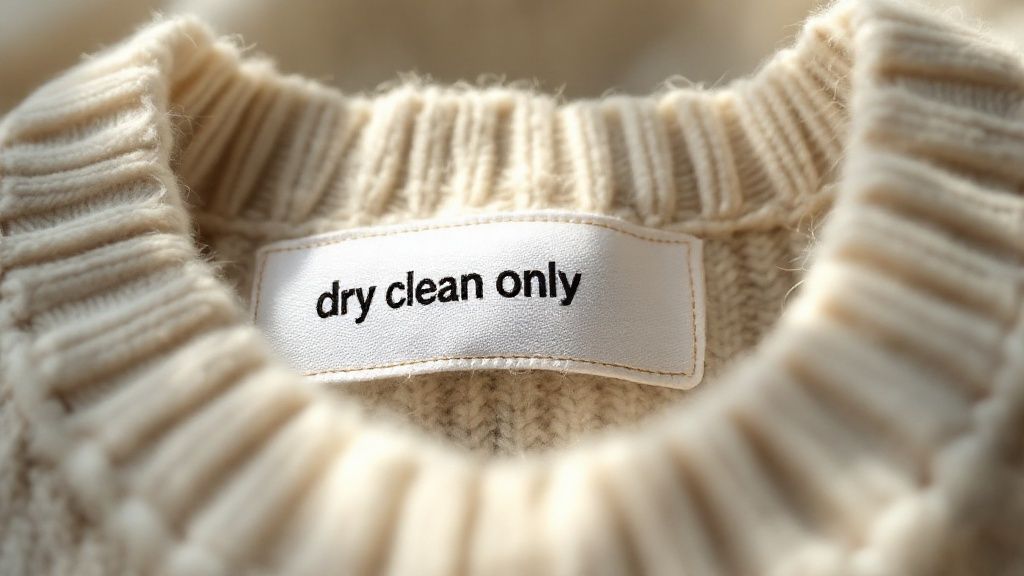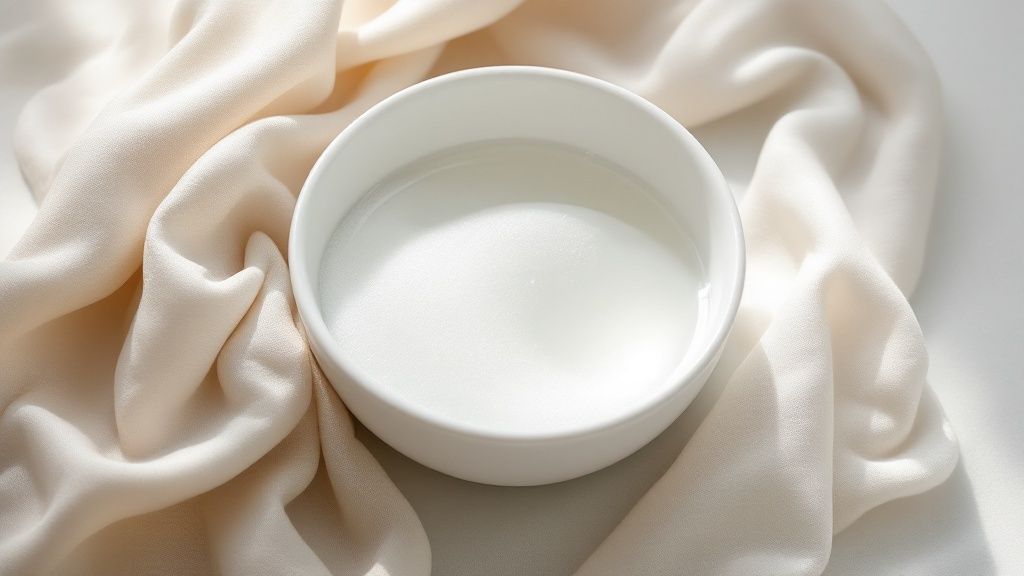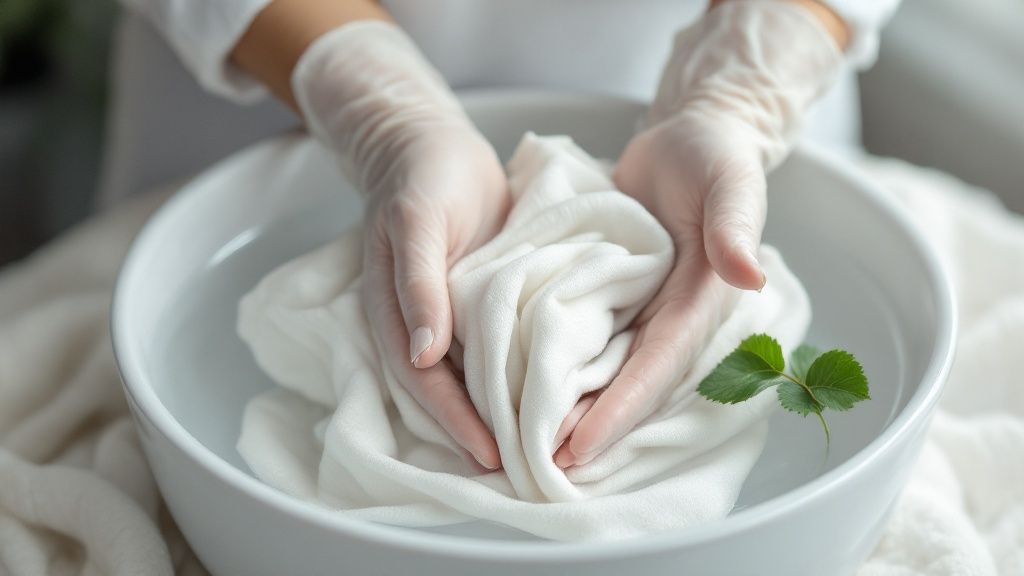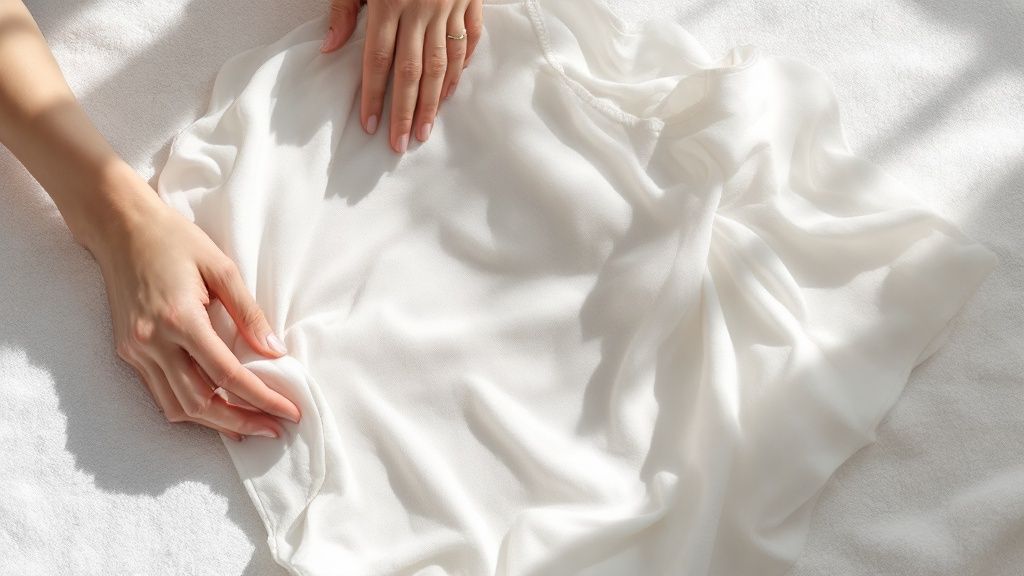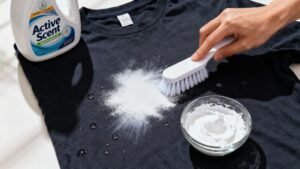
How to Wash Dry Clean Only Clothes at Home
So, you've got a favorite garment with that dreaded "Dry Clean Only" tag. Before you resign yourself to another trip to the cleaners, let's talk. Can you really wash these items at home?
The short answer is often, yes—but with the right approach. Many delicate materials, like certain wools and silks, can be gently hand-washed using cool water and a pH-neutral detergent. The secret is to test an inconspicuous spot first and completely avoid the washing machine and dryer, which are the real culprits behind most laundry mishaps.
Demystifying the Dry Clean Only Label
Think of that "Dry Clean Only" tag less as a strict command and more as a strong suggestion. Manufacturers often use it as a catch-all to protect themselves from liability if a garment gets damaged during a home wash. It's their way of recommending the absolute safest, most foolproof cleaning method.
But that doesn't mean it's your only option. With a little know-how, you can safely wash many of these pieces yourself, saving both time and money. Understanding what your fabric can handle is the first step to taking control of your laundry routine.
Why At-Home Care Is a Smart Choice
Washing your delicates at home puts you in the driver's seat. You control everything—the gentle handling, the quality of the detergent, and even the scent of the fabric softener. This hands-on method offers some real, practical benefits:
- Cost Savings: Those dry cleaning bills add up fast. Washing at home cuts down on a significant recurring expense.
- Convenience: Forget the constant trips to and from the dry cleaner. Care for your favorite pieces right when you need them.
- Gentler on Fabrics: Hand-washing with the right products can be far less harsh than the chemical solvents used in dry cleaning, potentially extending the life of your clothes.
Of course, trusting the professionals is still a popular choice. The global dry-cleaning market was valued at over USD 80 billion in 2025 and is expected to nearly double by 2035. This shows just how much people value expert care for certain items.
The real secret to washing 'dry clean only' items isn't about ignoring the tag—it's about understanding the fabric's true needs and applying a gentle, methodical approach that mimics professional care.
Learning to assess your garments is an empowering skill. Silks, for example, are often good candidates for a gentle hand-wash, but some types need extra attention. For more specific tips, you might find our guide on how to wash silk garments helpful. By learning to distinguish between what truly needs a professional's touch and what you can handle yourself, you take true ownership of your wardrobe.
Not all "dry clean only" fabrics are created equal when it comes to at-home washing. Some materials are much riskier to experiment with than others. This table breaks down which fabrics are generally safe bets and which ones you should probably leave to the pros.
At-Home Washing Risk Level by Fabric Type
| Fabric Type | Risk Level | Key Consideration |
|---|---|---|
| Cotton, Linen | Low | Generally very durable, but check for colorfastness. Can often handle a gentle machine cycle. |
| Polyester, Nylon, Spandex | Low | These synthetics are tough. A delicate cycle or hand-wash is almost always safe. |
| Cashmere, Wool | Medium | Can be hand-washed in cold water with a wool-specific soap, but agitation can cause felting (shrinking). |
| Silk | Medium | Hand-washing is usually fine, but dark or bright silks may bleed. Always spot-test first. |
| Rayon, Viscose | High | These fabrics can shrink, stretch, or lose their shape dramatically when wet. Proceed with extreme caution. |
| Structured Garments | Very High | Items like blazers or anything with lining or shoulder pads should always go to a professional. |
| Leather, Suede, Fur | Professional Only | Do not attempt to wash these at home. They require specialized cleaning processes to avoid permanent damage. |
Always start with fabrics in the "Low" risk category to build your confidence. As you get more comfortable with the process, you can decide if you're up for tackling the more delicate materials. When in doubt, though, the dry cleaner is your friend.
Gathering Your Tools for a Gentle Wash
Before you even think about getting that silk blouse wet, let's talk about setting yourself up for success. This isn't a job for harsh chemicals or your everyday laundry routine. Think of it more like assembling a toolkit for a delicate operation—one where every item is chosen to protect and pamper your most prized fabrics.
The star of the show is, without a doubt, your detergent. You absolutely need a pH-neutral, enzyme-free formula made specifically for delicates. These gentle cleansers are designed to lift away dirt without stripping the life out of sensitive fibers like silk or wool. It's your first and best defense against a laundry mishap. You can even find a quality laundry detergent without chemicals to add to your arsenal.
Your Essential Supply List
Beyond the right soap, a few other pieces of gear are non-negotiable. Each one plays a part in recreating that professional-level clean right in your own home.
- Mesh Laundry Bags: Honestly, these are your best friends. They are the simplest way to prevent snags, pulls, and stretching. Even if you're hand-washing with the utmost care, a stray zipper or button can catch. A mesh bag is cheap insurance.
- A Clean Basin or Tub: Using a basin gives you total control. You can gently submerge and swish the garment, avoiding the aggressive mechanical churning of a washing machine.
- Soft, Absorbent Towels: You'll need a couple of these for blotting away excess water after the wash. The golden rule here is to never wring out delicates. Gently pressing them between soft towels is the only way to go.
- Padded or Contoured Hangers: Those flimsy wire hangers are a recipe for disaster. They create ugly shoulder bumps and can stretch out a wet, heavy garment beyond repair. Padded hangers are essential for helping your clothes keep their natural shape while they air-dry.
Choosing the right tools is the first step in replicating a professional clean. It’s a methodical approach that prioritizes fabric preservation over speed, ensuring your favorite garments remain in pristine condition.
Something else to consider is your water quality. It can have a bigger impact than you'd think. Hard water, for example, can leave fabrics feeling stiff and make your detergent less effective. It’s worth understanding water softeners if you live in an area with hard water. The goal is to control every variable, from the soap you choose to the water it’s mixed with.
Your Pre-Wash Preparation Checklist
What you do before your garment ever touches water is just as critical as the wash itself. Think of this as your chance to prevent disaster and make sure your favorite pieces survive the process unscathed.
And the single most important step? The spot test. This is your non-negotiable insurance policy.
This quick check tells you exactly how the fabric will react to water and detergent. It’s how you spot potential color bleeding or weird texture changes before you commit to submerging the entire item.
Performing the Perfect Spot Test
Never, ever skip this, especially when you're working with vibrant or dark-colored fabrics. Find a hidden area on the garment—an inner seam, the inside of a hem, or even a fabric swatch if one was included.
- Take a clean, white cloth or a cotton swab and dab a tiny amount of your diluted detergent onto the spot.
- Gently rub the area and just let it sit for a few minutes.
- Blot the spot with another clean, damp white cloth.
- Now, check the cloth for any color transfer. If you see dye on it, the garment is going to bleed and isn't a good candidate for hand-washing.
- Let the test area air dry completely. You're looking to see if the fabric’s texture or appearance changes in any way.
A successful spot test is your green light. If there's no color bleeding and the fabric looks and feels the same after drying, you can confidently move forward.
This methodical approach is the secret to learning how to wash dry clean only items without a single regret. While more people are trying at-home care—somewhere around 20-30% of consumers—it's not without its risks. Industry data shows that improper techniques can damage up to 50% of delicate materials, leading to shrinkage or distortion.
Pre-Treating Stains and Final Checks
Before you start the wash, give your garment a quick once-over for any stains. Instead of aggressive scrubbing, which is a fast way to damage delicate fibers, just gently dab a small amount of your detergent directly onto the stain. Let it sit for about 10 minutes before washing.
For more stubborn spots, we have some detailed advice on how to remove stains from a shirt.
Finally, take a moment for these simple but essential habits:
- Empty all pockets. Trust me, you don't want to find a soggy tissue or—even worse—an ink pen disaster.
- Secure all closures. Zip up zippers, fasten buttons, and close any hooks. This keeps them from snagging the delicate fabric during the wash.
Following this pre-wash ritual turns a risky guess into a controlled, confident process, ensuring your clothes get the care they truly deserve.
The Art of Hand-Washing Delicate Fabrics
Now that you've prepped your garment, it's time to get your hands wet. This is where patience and a gentle touch make all the difference, transforming a potentially risky wash into a rewarding ritual. We're not just cleaning here; we're preserving the integrity of the fabric, mimicking the careful handling of a professional.
The first, and most important, rule is simple: always use cool water. Anything warmer is a recipe for disaster. Hot water can cause sensitive fibers like wool to shrink instantly or make the vibrant dyes in your favorite silk blouse bleed. Fill your basin with enough cool water to let the garment move around freely—it shouldn't feel cramped.
Creating the Perfect Wash Bath
Before the garment even touches the water, you need to prepare the wash bath. Add your specialized detergent and give it a good swirl with your hand until it's completely dissolved. You're looking for a light scattering of suds, not a mountain of foam. This little step ensures the cleaning agents are evenly distributed and prevents concentrated soap from sitting directly on the fabric.
This is where the right detergent truly shines. Many of us prefer an unscented formula that delivers pure cleaning power without clashing with our signature perfumes or softeners. The goal is powerful cleaning with zero interference. Active Scent's odor-free laundry detergent, for example, has been carefully formulated for a deep and effective clean, without competing fragrances. It creates the ultimate neutral base, designed to perfectly complement the range of luxury scented fabric softeners you might add later. You can learn more about how a neutral base enhances your laundry experience on our site.
The key to a successful hand-wash is in the motion. It’s a gentle dance of swishing and pressing—never the aggressive twisting or wringing you might use with tougher fabrics.
Once your wash bath is ready, submerge the garment completely. Gently swish it back and forth through the water with your hands. If you have any soiled areas, you can softly press the soapy water through the fibers. This delicate motion is all you need to lift dirt without stretching or stressing the material.
Soaking and Rinsing The Right Way
Knowing how to wash dry clean only items comes down to mastering the timing. Unlike sturdy cottons that can handle a long soak, delicate fabrics can actually weaken if left submerged for too long.
- Soaking Time: For most items, a soak of 15-20 minutes is perfect. Set a timer so you don't forget. For something incredibly delicate like silk, you can even cut this down to just 5-10 minutes.
- The Pressing Technique: Resist the urge to wring it out! Instead, gently press the garment against the side of the basin to squeeze out the excess soapy water.
- The Rinsing Process: Drain the sudsy water and refill the basin with fresh, cool water. Submerge the garment again, swishing it around to rinse out the detergent. You'll likely need to repeat this two or three times until the water runs completely clear and you see no more suds. It's a critical step to prevent soap residue from dulling the fabric's finish.
This patient, methodical approach is what ensures your clothes emerge beautifully clean without any of the damage that comes from a rough wash. It’s all about respecting the fabric and giving it the gentle care it deserves.
How to Dry and Finish Your Garments Perfectly
You’ve carefully hand-washed your garment, and now comes the part that makes all the difference. How you dry and finish these pieces is what separates a decent home wash from a truly professional result.
The biggest mistake you can make? Even looking at your machine dryer. It's the number one enemy of delicate fabrics, notorious for causing irreversible shrinkage and damage.
First things first, you need to get the excess water out—gently. Forget any harsh wringing or twisting. Instead, master the "towel burrito" trick. Lay a clean, thick towel flat, place your freshly rinsed garment on it, and gently roll the towel up with the garment inside. Press softly as you go. This simple move absorbs a surprising amount of moisture without stressing a single fiber.
Air-Drying With Precision
Once you’ve blotted out the bulk of the water, it's time to air-dry. But just slinging your piece over a chair won't cut it. The right method depends entirely on the fabric's structure.
- For Knits (like sweaters): Always lay these items flat. Use a fresh, dry towel or a mesh drying rack. If you hang a wet knit, gravity will stretch the fibers, leaving you with a shapeless garment that's suddenly two sizes too big.
- For Wovens (like blouses or dresses): These can be hung, but only on a padded or contoured hanger. This supports the garment's natural shape and prevents those dreaded shoulder bumps that are nearly impossible to get out later.
Specialty items often have their own rules. For instance, when you learn how to wash down jackets, you realize the drying process is just as crucial as the wash itself to restore that essential loft and fluffiness.
The final finishing touches are what elevate a home wash from simply 'clean' to 'flawlessly cared for.' It's the art of making it look like it never left a professional's hands.
It's this meticulous level of care that leads many to stick with the pros. In North America, the dry cleaning and laundry services industry pulled in nearly $19 billion in revenue as of 2024, with home consumers making up almost 60% of that market. These numbers prove just how seriously people take those "dry clean only" labels. You can dive deeper into the dry cleaning market on grandviewresearch.com.
The Secret to a Wrinkle-Free Finish
After your garment is completely dry, you'll probably see a few wrinkles. Resist the impulse to grab a hot iron—it can easily scorch delicate materials like silk or rayon.
Your best friend for a crisp, polished finish is a handheld steamer.
Hold the steamer a few inches from the fabric and use gentle, sweeping motions. The steam relaxes the fibers and releases wrinkles without any harsh, direct heat. This last step is what truly transforms the final look, making it appear as though it just came back from the dry cleaner.
Your Top Questions, Answered
Even with a solid plan, a few questions are bound to pop up. Learning to care for your "dry clean only" items is a process, and a little extra insight can give you the confidence you need to dive in. Let's tackle some of the most common worries.
What about those "at-home dry cleaning kits"? Do they actually work? Honestly, for a light refresh—say, to lift minor odors or ease a few wrinkles from a sturdy wool sweater—they can be okay. Think of them as a step up from a fabric spray, not a true deep clean.
But let's be clear: they are no substitute for a real wash. These kits usually just use a scented sheet and your dryer's heat to steam a garment. They won’t touch set-in stains or serious grime. And for truly delicate fabrics like silk or rayon, that dryer heat is still a huge risk.
When to Call in the Professionals
Knowing how to wash your delicates is empowering, but knowing when not to is just as crucial. Some jobs are simply best left to the pros.
Always head to the dry cleaner for these situations:
- Structured Pieces: Anything with complex construction like blazers, tailored trousers, or formal wear. Water can make the outer fabric and inner linings shrink at different rates, completely warping the garment's shape. It’s a disaster you can’t undo.
- Tough or Mystery Stains: Oil-based stains (salad dressing is a classic culprit) or spots you can’t identify need professional-grade solvents. Don't experiment on these at home.
- Intricate Details: Garments with beading, sequins, delicate embroidery, or lace are incredibly easy to snag and destroy in a home wash, no matter how careful you are.
- Suede, Leather, & Fur: These materials are non-negotiable. They require highly specialized cleaning and should never, ever be put in water.
Here's a simple rule of thumb: hand-washing is for simple, single-layer garments. Anything complex, precious, or heavily stained deserves a trip to the professionals. It’s just not worth the heartbreak.
Handling Stains the Right Way
So, you've just spilled something on that favorite silk top right before you were planning to wash it. What now? Your stain removal technique needs to be just as gentle as your washing method. The number one rule is never scrub.
Instead, gently blot the stain with a clean, white cloth to lift as much of the spill as possible. For water-based stains like coffee or wine, you can try dabbing the spot with a tiny amount of your pH-neutral detergent mixed with cool water. For anything oil-based, your best bet is to stop and take it straight to a professional.
The key is always to act fast but gently. And remember to spot-test your cleaning solution on a hidden area first.
Ultimately, mastering at-home care for your delicates is all about building confidence through careful, precise steps. Follow these principles, and you'll keep your most cherished pieces looking beautiful for years to come.
LAUNDRY NEVER SMELLED SO GOOD! Fuse powerful detergents with luxurious fragrances inspired by renowned houses like Dior and Chanel. Each wash delivers a spark of joy and a surge of confidence with an EXCEPTIONAL product. Discover the full experience at https://active-scent.com.


